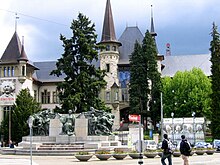Bern Historical Museum
 The Museum entrance on Helvetiaplatz | |
 Location within Bern | |
| Established | 1894 |
|---|---|
| Location | , Bern, Switzerland |
| Coordinates | 46°56′35″N 7°26′57″E / 46.94306°N 7.44917°ECoordinates: 46°56′35″N 7°26′57″E / 46.94306°N 7.44917°E |
| Type | History |
| Collection size | 500,000[1] |
| Director | Jakob Messerli |
| Architect | André Lambert |
| Website | www |

The Bern Historical Museum (German: Bernisches Historisches Museum, French: Musée d’Histoire de Berne) is the second largest historical museum in Switzerland. It was designed by the Neuchâtel architect André Lambert and built in 1894.[2] Since it was initially conceived as the Swiss National Museum (which the city of Zurich was later chosen to host), the architect took as his model various historic castles from the 15th and 16th centuries.[3] An extension to the original museum building was completed in 2009.
The museum contains collections related to the history of Bern from prehistoric times to the present and other artefacts on permanent display from Asia, Oceania, America and Egypt. One of the most remarkable items in the collection is the Muri statuette group, a group of six Gallo-Roman bronze figurines.
The Bern Historical Museum is a heritage site of national significance.[4]
Over the museum's entrance is a glass mosaic, "The Age of History", featuring the figures of Poetry and History, made in 1900 by the Swiss painter Léo-Paul Robert.[5]
Einstein Museum[]

First conceived as a temporary exhibition in 2005, the Einstein Museum became a museum dedicated to the life and work of Albert Einstein, who developed the Relativity Theory while living in Bern. The house where he lived (Einsteinhaus) in this period is also open to the public, but is located elsewhere in the city and charges separate entry fees.
Footnotes[]
- ^ Museum website accessed 18 September 2017
- ^ Museum website-History accessed 18 September 2017
- ^ Museum website-Architecture accessed 18 September 2017
- ^ "Swiss inventory of cultural property of national and regional significance". A-Objects. Federal Office for Cultural Protection (BABS). 1 January 2017. Archived from the original on 28 June 2010. Retrieved 6 September 2017.
- ^ "Exterior views". Bernisches Historisches Museum. Retrieved 24 April 2019.
External links[]
| Wikimedia Commons has media related to Bernisches Historisches Museum. |
- History museums in Switzerland
- Museums in Bern
- Cultural property of national significance in the canton of Bern


